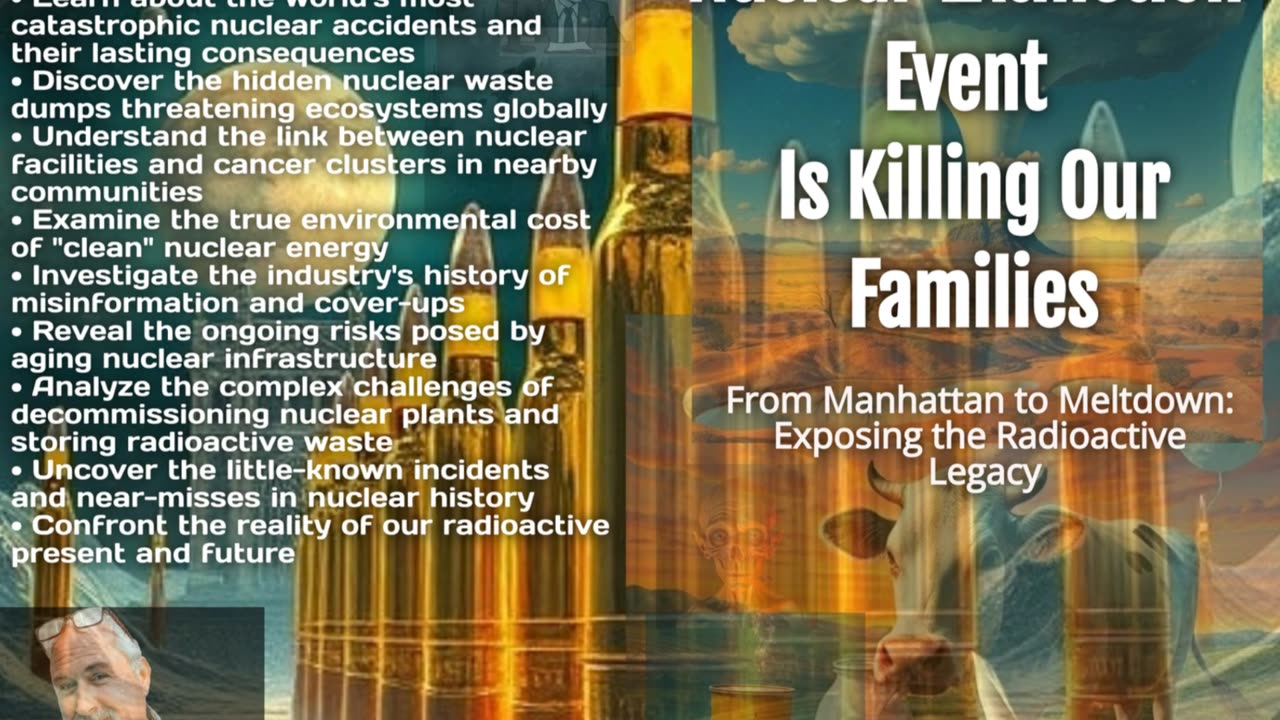Premium Only Content

MilK Testing For Radiation From Fukushima Hawaii: Levels High and Cancer Rates Higher Today
Buy Book Link
https://amzn.to/3YLD9Ni
This book exposes the unfolding nuclear energy crisis and its impact on human health and the environment. From the Manhattan Project's legacy to today's disasters, it reveals how radiation permeates our world in real-time. The author uncovers suppressed truths about nuclear accidents, waste disposal issues, and long-term health effects as they happen.
Readers will discover the hidden costs of this technology—contaminated landscapes, cancer clusters, and genetic damage passed to future generations. The book examines how governments and industry downplay risks while pursuing atomic ambitions, even as new incidents occur. It presents the latest data and expert opinions to question nuclear power's sustainability in an age of climate issues and renewable alternatives.
Through meticulous research and compelling narratives, this work sounds an urgent alarm about an ongoing catastrophe. It argues that continued reliance on nuclear energy threatens humanity's survival. Drawing on cutting-edge scientific projections, the final chapter explores how radioactive pollution may trigger the next mass extinction event.
Mainstream media often censors or downplays nuclear-related incidents and health concerns. Many deaths and illnesses linked to radiation exposure go unreported or are attributed to other causes. Millions suffer from radiation-induced illnesses, often undiagnosed or misdiagnosed. The true extent of nuclear technology's impact on human health remains hidden.
Radioactive contamination of the Earth continues to increase every minute. Nuclear power plants, weapons testing, and industrial activities release radiation into the environment constantly. This cumulative effect poses an ever-growing threat to all life on the planet.
This is an uncompromising, up-to-the-minute look at one of the gravest perils facing our planet today. It challenges readers to confront the reality of our nuclear present and future.
The Fukushima Disaster occurred on March 11, 2011. The meltdown explosion produced a radioactive plume cloud across the Pacific Ocean. Authorities tested milk in Hawaii on March 4, 2022. Tests found radioactive strontium, cesium, and iodine isotopes. After Hawaii's milk tests, many USA cities stopped testing milk.
Hawaii has higher overall cancer incidence rates than the U.S. average, ranking 5th highest for breast cancer incidence. The state's cancer burden varies by specific cancer type.
There is no safe level of radionuclide exposure. Exposure to iodine-131, cesium-137, cesium-134, and strontium isotopes increases cancer risk. The EPA shut down some radiation testing.
In 2011, the EPA conducted radiation fallout tests in more than 100 USA locations. Failure to report detections left the public uninformed about the extent of the contamination.
These beta isotope daughters had half-lives of 60 days or less. Uranium and plutonium have half-lives of thousands of years. In meltdowns, uranium and plutonium stay local. The Fukushima explosion created beta radiation isotopes.
Fukushima's radioactive meltdown exposed American beef to fallout. Five days later, wind and jet stream dumped it on the USA. Ten days later, it reached Britain and Russia.
Authorities only tested radiation levels of uranium and plutonium. These nuclear reactor alpha particles would not affect the USA and stay local. The Fukushima explosion created rare radioactive cesium and iodine particles with shorter half-lives.
Authorities waited one year before testing these beta isotopes. Testing resumed after the radioactive daughters' half-lives diminished. The administration increased acceptable radiation levels in food, water, and soil.
The EPA still monitors the beta radiation isotopes. In 2011, it took 12 months to report beta radiation fallout.
This incident was not isolated. Hundreds of atomic bomb tests rained fallout over America. These events also went unreported. Government agencies failed to provide timely, accurate information.
Nuclear weapons testing in the USA during the 1950s and 1960s released radioactive isotopes across the country. Evidence suggests that this radiation exposure likely contributed to an increased risk of leukemia.
Authorities tell us that the long-term effects of radiation exposure through food remain understudied. Radiation's impact on agriculture extends beyond immediate contamination. Soil can retain radioactive particles for a long time.
The Fukushima incident exposed weaknesses in global disaster response protocols. Radiation release revealed gaps in international cooperation on radiation monitoring. Countries struggled to coordinate efforts and share data.
The public health implications of long-term radiation exposure remain debated. Some experts argue for more conservative safety thresholds, while others maintain that current standards provide adequate protection.
.
-
 38:41
38:41
MYLUNCHBREAK CHANNEL PAGE
1 day agoTimeline Begins in 1800? - Pt 1 & 2
81K46 -
 1:23:41
1:23:41
Game On!
1 day ago $11.87 earnedNetflix NFL Christmas Games Preview and Predictions!
74.6K9 -
 2:05:07
2:05:07
Darkhorse Podcast
1 day agoWhy Trump Wants Greenland: The 257th Evolutionary Lens with Bret Weinstein and Heather Heying
303K590 -
 8:50:58
8:50:58
Right Side Broadcasting Network
1 day ago🎅 LIVE: Tracking Santa on Christmas Eve 2024 NORAD Santa Tracker 🎅
393K58 -
 2:48
2:48
Steven Crowder
1 day agoCROWDER CLASSICS: What’s This? | Nightmare Before Kwanzaa (Nightmare Before Christmas Parody)
349K13 -
 33:49
33:49
Quite Frankly
1 day agoThe Christmas Eve Midnight Telethon
139K23 -
 2:12:46
2:12:46
Price of Reason
1 day agoAmber Heard BACKS Blake Lively Lawsuit Against Justin Baldoni! Is Disney CEO Bob Iger in TROUBLE?
85.9K24 -
 1:01:17
1:01:17
The StoneZONE with Roger Stone
1 day agoChristmas Edition: Why the Panama Canal is Part of the America First Agenda | The StoneZONE
154K53 -
 18:12:15
18:12:15
LFA TV
1 day agoLFA TV CHRISTMAS EVE REPLAY
162K19 -
 13:32
13:32
Scammer Payback
1 day agoChanging the Scammer's Desktop Background to his Location
27.8K6